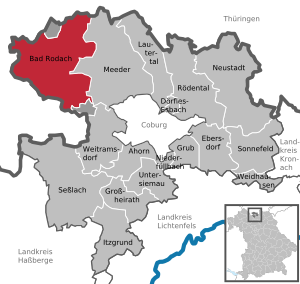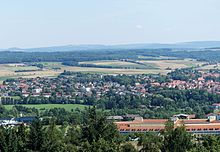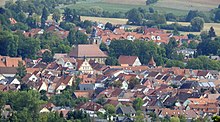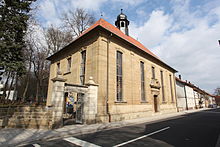Bad Rodach
| coat of arms | Germany map | |
|---|---|---|

|
Coordinates: 50 ° 20 ' N , 10 ° 47' E |
|
| Basic data | ||
| State : | Bavaria | |
| Administrative region : | Upper Franconia | |
| County : | Coburg | |
| Height : | 320 m above sea level NHN | |
| Area : | 77.65 km 2 | |
| Residents: | 6418 (Dec. 31, 2019) | |
| Population density : | 83 inhabitants per km 2 | |
| Postal code : | 96476 | |
| Area code : | 09564 | |
| License plate : | CO, NEC | |
| Community key : | 09 4 73 158 | |
| City structure: | 19 districts | |
City administration address : |
Markt 1 96476 Bad Rodach |
|
| Website : | ||
| First Mayor : | Tobias Ehrlicher ( SPD ) | |
| Location of the city of Bad Rodach in the Coburg district | ||
Bad Rodach (until 1999 Rodach ) is a town in the Upper Franconian district of Coburg . Since 1999 the city has been recognized as a spa with the warmest thermal spring in Franconia .
geography
location
The city is located in the north of Bavaria in the Coburg district , not far from the border with Thuringia . It is located around 18 kilometers northwest of Coburg between the Long Mountains in the east and the Gleichbergen in the west on the Rodach River .
City structure
Bad Rodach has the following 19 parts of the municipality:
Neighboring communities
There are the following neighboring communities:
|
|
and the unincorporated area
history
Until the move to Bavaria
The beginnings of Rodach, which was called "Radaha" or "Rotaha" in the early Middle Ages, go back to the second half of the 8th century. For the first time he was in one of Arnulf III. on March 11, 899 in Regensburg mentioned. With the document, Arnulf III. some of his areas back to his servant Pippo, who was formerly king of these areas, in order to save his soul. The Grattstadt district was first mentioned in a deed of donation from the year 815 or 823, with which an "Erluuin" (Erwin) gave his goods in "Grezzistat (Grecestetten, Grazzestadt)" in the Grabfelde to the Fulda monastery.
In 1362 Rodach received city rights . Around 1300 an urban settlement was founded around the market square , which was surrounded by a city wall in 1386 and received its own jurisdiction in 1425. With the Reformation the Evangelical Lutheran denomination was introduced in Rodach .
In Rodach was located "at the Siechbrücke" a medieval leper colony , which was called the "House for Sondersieche". A year of the first mention is not known.
Bad Rodach owned a stud , the Rodach Stuterei , which was first mentioned in writing in 1524 and closed around 1806 after the stables had been torn down by a strong storm and no longer rebuilt. There are indications that horse breeding existed long before the first written mention; Place names such as Roßfeld and Mähreausen, which belonged to what was then Rodach, were mentioned as early as the 13th century.
From 1531 Rodach was expanded into a state fortress, the stones of which came from the Georgenberg Monastery , which was demolished after 1550 .
In the Thirty Years War the city was destroyed in 1632 and burned down except for a few houses. In 1634 the city was sacked by imperial troops and suffered from a famine in 1635 that killed 808 people. The city was rebuilt and the first industrial establishments sprang up in the early 19th century. In 1825 the western city wall was torn down; the stones were used to rebuild the houses on the market square that had recently burned down. In 1857 the remaining city wall with the Coburg Gate and the gate tower was demolished.
On July 1, 1892, the city received a railway connection with Coburg. In 1911 the municipal power station was put into operation.
In 1920 the Free State of Coburg , to which Rodach belonged, joined the Free State of Bavaria.
20th and 21st centuries
In the state treaty it was agreed that Rodach should remain an independent city . Nevertheless, on April 1, 1940, it was incorporated into the Coburg district .
On April 10, 1945, the US Army captured Rodach after an artillery bombardment . "Great destruction during the invasion of the Americans" reads a display at the town hall. The town church was also affected. From then on Rodach belonged to the American zone of occupation. For more than 40 years, the inner German border separated the city of Rodach from its Thuringian hinterland.
In 2016, the core city had almost 3900 inhabitants and around 4000 jobs.
Development into a spa
On March 1, 1972, Northern Bavaria's warmest thermal spring (34 ° C) was developed at a depth of 652 meters. She founded the development of the city into a spa. To use this thermal spring, a thermal exercise bath was built from 1973 and inaugurated on June 5, 1976. In 1981 Rodach was recognized by the state as a resort and in 1999 it was recognized as a spa . Today there is the ThermeNatur Bad Rodach with bathing and sauna area and wellness department.
On November 18, 1989, the inner-German border was opened and the road to Adelhausen, a neighboring town in southern Thuringia, was opened for through traffic. The spa gardens (1989), the extended thermal baths (1996), a clinic (1997) and a senior citizen center (1998) were created. On January 29, 1999, the name was changed to Bad Rodach.
Religions
The Rodach town church St. Johannis was elevated to a parish church in 1350 and has belonged to the Evangelical Lutheran Church since the Reformation . There are other Protestant churches in the districts of Breitenau, Elsa, Gauerstadt, Grattstadt, Heldritt, Oettingshausen and Roßfeld. There has also been a Roman Catholic Church in Rodach since 1957, and there is also a New Apostolic Church today .
Incorporations
| Former parish |
Residents (1970) |
date | annotation |
|---|---|---|---|
| Breitenau | 204 | 05/01/1978 | |
| Elsa | 292 | 05/01/1978 | |
| Gauerstadt | 581 | 05/01/1978 | with Carlshan and Niederndorf |
| Ridge town | 269 | 07/01/1971 | Merger with Heldritt zu Langenbergen |
| Hero third | 665 | 07/01/1971 | Merger with Grattstadt zu Langenbergen |
| Langenbergen | - | 05/01/1978 | |
| Lempertshausen | 138 | 01/01/1975 | |
| Moravia home | 157 | 01/01/1972 | |
| Oettingshausen | 126 | 01/01/1975 | |
| Rossfeld | 305 | 07/01/1971 | |
| Rudelsdorf | 25th | 01/01/1970 | |
| Schweighof | 18th | 04/01/1928 | Incorporation after Elsa |
| Sülzfeld | 84 | 01/01/1972 |
Population development
In the period from 1988 to 2018, the city grew from 6,149 to 6,394 by 245 inhabitants or 4%. A peak was reached on December 31, 2000 with 6672 inhabitants.
politics
City council
The local elections on March 15, 2020 led to the following distribution of seats in the city council (2014 seats in brackets):
| CSU | 5 seats (4) |
| GREEN | 2 seats (0) |
| SPD | 6 seats (7) |
| Free voters | 4 seats (6) |
| Bad Rodach future forum | 1 seat (3) |
| ÖDP | 1 seat (0) |
| Social and citizen-friendly for Bad Rodach | 1 seat (0) |
mayor
Tobias Ehrlicher (SPD) has been the city's first mayor since November 1, 2012. He was elected at the age of 25, making him one of the youngest mayors in Germany. Although he had two opposing candidates, he received 68.9 percent of the votes cast in the first ballot. In the mayoral election in 2020 he was re-elected with 70.3% of the valid votes.
coat of arms
| Blazon : "A red armored black lion in gold." | |
Culture and sights
theatre
- Waldbühne Heldritt with 800 roofed spectator seats in Heldritt . Every year from July to August, a children's play and a comedy by the Heldritt home association are performed, as well as an operetta from the Coburg summer operetta .
Night watchman
Since 1982 there are night watchmen again in (Bad) Rodach. In 2012 they celebrated their 30th anniversary. Bad Rodach is the cradle of the European night watchman and doorman guild, which was founded in 1987 in Ebeltoft, Denmark.
Walter Kienel, after Wolfgang Grosch the second night watchman in Rodach, was the guild master of this European community from the founding of the guild until 2004. For health reasons he had to give up the office and was honorary guild master until his death. The guild master is Johannes Thier.
The performances of the Bad Rodach night watchmen always take place on Thursdays from May to September. At 7:30 p.m. there is the opportunity to visit the night watch tower on the city wall in advance. The night watchman tour begins at 8:00 p.m. and the meeting point is Bad Rodach Palace Square. On the first Thursday of the month, instead of the night watchman tour, the night watchman performance at the Powder Tower at the old school takes place at 8:00 p.m., which is then musically accompanied by a local band. The night watchmen tell and comment on current events in the form of rhymes, accompanied by horn blows. Your code of honor is to design each appearance with new verse.
- "Hear you people, we announce
- we don't mince words,
- everything that happens around us
- is attached, rhymed and commented on.
- We inform the guests
- the good and the bad we shout,
- we stand up for our city,
- which has a good thermal bath. "
Health resort
- ThermeNatur Bad Rodach, state-approved mineral spring spa
Baths
- Waldbad, opened in 1932
Museums
- Local museum
music
The Rodacher Rückertkreis regularly organizes concerts and lectures. Artists like Siegfried Jerusalem and Susanne Kessel are regular guests in Bad Rodach. The club owns a grand piano from Steinway & Sons , which attracts many internationally known artists to Bad Rodach.
Buildings
- Old courthouse
- Friedolinhaus
- Hunting lodge
- Johanniskirche
- Georgenberg Monastery (remains of the chapel)
- Salvator Church
- St. Mary
- Henneberger Warte
- Churches in the districts
Evangelical branch church St. Paulus in Grattstadt
Parks
- Spa park between the thermal baths, the spa clinic and the senior citizens' home. It was created in 1989.
- Park by the moat and along the old city wall with very old trees.
- Rückertweg at the city wall, created in honor of Friedrich Rückert. Bronze plaques with poems by the Franconian poet are placed along the city wall.
- Small spa garden, above the thermal bath. There is a brass concert there every Sunday morning.
Regular events
- Every first Thursday of the month (except in January) there is a large Krammarkt on the market square and along Heldburger Straße.
- On one of the Sundays in summer, the nationally known Roesler-Boerse takes place, which derives its name from the former fine stone ware factory Max Roesler. The theme of this exchange is fine stoneware.
- Europeans' Day has been taking place in Bad Rodach every July since 2001 .
- Every year on the third Advent the Franconian Christmas , the city's Christmas market, is held.
Economy and Infrastructure
The wood , plastic and toy industry is a traditional economic focus. Alongside tourism, it is still an important industry. The city has 3,300 jobs, 800 employees commute and 1,800 to Bad Rodach.
traffic
The Bavarian state road No. 2205 leads from Coburg to Bad Rodach and the Thuringian border.
The railway line between Bad Rodach and Coburg was regularly used by Deutsche Bahn every 2 hours until June 2011, following closure plans in the 1980s . Since then, the private railway company Agilis has offered an hourly service on the connection, and the trains usually run via Lichtenfels , Kulmbach and Bayreuth to Weiden in the Upper Palatinate .
There is also a bus line from Coburg via Bad Rodach to Hildburghausen.
Established businesses
With more than 1500 employees, the HABA group of companies is the largest employer in the city. The family company was founded in 1938 by, among others, Eugen Habermaaß and produces toys as well as school and kindergarten furniture.
Valeo Klimasysteme GmbH, a subsidiary of the Valeo Group , employs around 850 people in its Rodach plant (as of 2013). The company manufactures heating and air conditioning systems for the automotive industry.
The Max Roesler Feinsteingutfabrik , founded by Max Roesler on July 23, 1894, originally stood on the factory premises on the Coburg – Bad Rodach railway line . In 1910 about 400 people were employed there. In 1919 Roesler sold the corporation to the Dresdner banking house Gebrüder Arnhold . In 1938, in the course of the Aryanization of Jewish property, Dresdner Bank took over the assets of the Arnold brothers' banking house and thus became the owner of Max Roessler AG. Through the mediation of the Nazi Bavarian Prime Minister Ludwig Siebert bought Siemens Schuckertwerke the company of Dresdner Bank. It was not until 1943 that the company name was renamed Siemens-Schuckertwerke Porzellanfabrik Rodach. With up to 1000 employees, including forced laborers from the USSR and Poland, porcelain insulators were manufactured until the end of the war. After the end of the war, fine stoneware production was resumed in 1945, and from 1965 Siemens concentrated on the manufacture of plastic parts using the injection molding process. In 1995 Siemens sold the plant to Valeo.
There is also Christian Hofmann GmbH, founded in 1878, which manufactures movable and immobile figures for showmen and parks.
education
Elementary school and middle school are available.
Personalities
Honorary citizen
- 1988: Luise Habermaaß, entrepreneur
- 2011: Klaus Habermaaß, entrepreneur
Personalities who worked in Rodach
- In 1814 the poet Friedrich Rückert spent a few days in Rodach and wrote his poem Idylle Rodach .
- Max Roesler , who had been managing director of the Wächtersbacher ceramics factory for many years , started his own business in Rodach in 1894 at the age of 50 and founded a fine stoneware factory. After a personal stroke of fate, Roesler sold the company in 1919. His daughter, the poet and artist Paula von Goeschen-Roesler (1875–1941), who was best known for her paper cuttings , lived in Rodach from 1893 to 1902. Four of her large-format works hang in the Bad Rodach hunting lodge.
- The composer Felix Draeseke (1835–1913) was born in Coburg and grew up in Rodach. His house is behind the former hunting lodge of the Coburg dukes.
- Superintendent Christian Hohnbaum (1747-1825) was a good friend of Friedrich Rückert and hosted his stay in Rodach. He composed the Rodach Christmas carol .
- Helmut Markwort , journalist, publishing manager and former editor-in-chief and publisher of the news magazine Focus , spent part of his youth in Bad Rodach. He was housed there with his family during the Second World War and attended elementary school.
Others
In 1775, a stone meteorite weighing around 2.9 kilograms and not classified in detail fell near the town . He was registered under the official name Rodach .
literature
- Helga Augustin: The Rodach stud farm - borderline cases - disputes - vicissitudes of a sovereign stud in three centuries. Bad Rodach 2007.
- Egbert Friedrich: Rodach Hunting Lodge - from the Prince. Hunting lodge to the guest's house. Bad Rodach 1984.
- Irmhild Tschischka: Leafed through the chronicle of Bad Rodach's districts - a piece of Bad Rodach's city history. Bad Rodach 2005.
Web links
|
Further content in the sister projects of Wikipedia:
|
||
|
|
Commons | - multimedia content |
|
|
Wikisource | - Sources and full texts |
|
|
Wikivoyage | - Travel Guide |
- Official website of Bad Rodach
- History of the Bad Rodach spa
- Entry on the coat of arms of Bad Rodach in the database of the House of Bavarian History
- Bad Rodach: Official statistics of the LfStat (PDF, 1.67 MB)
Individual evidence
- ↑ "Data 2" sheet, Statistical Report A1200C 202041 Population of the municipalities, districts and administrative districts 1st quarter 2020 (population based on the 2011 census) ( help ).
- ↑ Bad Rodach, List of official parts of the municipality / districts in the BayernPortal of the Bavarian State Ministry for Digital, accessed on August 14, 2020.
- ^ Bad Rodach in the local database of the Bavarian State Library Online . Bavarian State Library, accessed on August 14, 2020.
- ↑ Guido Reinhardt: Geschichte des Marktes Gräfentonna , Langensalza 1892. This book contains the note on the year “823” (according to others “815”).
- ↑ Documentation: Medieval leprosories in today's Bavaria, originally in "Die Klapper" 1995, magazine of the Society for Leprosy, accessed August 17, 2017 ( Memento of the original from February 6, 2015 in the Internet Archive ) Info: The archive link was automatically inserted and still Not checked. Please check the original and archive link according to the instructions and then remove this notice. , see also mention of the Siechbrücke in the book "Rodach in old views, Volume 2"
- ↑ Helga Augustin: The Rodach stud farm - borderline cases - disputes - vicissitudes of a sovereign stud in three centuries , Bad Rodach 2007.
- ↑ Information boards on the town hall and church (2016)
- ↑ StBA: Changes in the municipalities in Germany, see 1999
- ↑ a b c d e f Federal Statistical Office (ed.): Historical municipality register for the Federal Republic of Germany. Name, border and key number changes in municipalities, counties and administrative districts from May 27, 1970 to December 31, 1982 . W. Kohlhammer GmbH, Stuttgart / Mainz 1983, ISBN 3-17-003263-1 , p. 679 and 680 .
- ↑ a b c d e f g Wilhelm Volkert (Ed.): Handbook of the Bavarian offices, municipalities and courts 1799–1980 . CH Beck, Munich 1983, ISBN 3-406-09669-7 , p. 442 .
- ↑ Mayor election of Bad Rodach, March 15, 2020. Bad Rodach city administration, accessed on May 24, 2020 .
- ^ Entry on the Bad Rodach coat of arms in the database of the House of Bavarian History
- ↑ see Wikipedia article on banking house Gebrüder Arnhold
- ↑ Rodach. Meteoritical Bulletin, accessed June 30, 2020 .




















